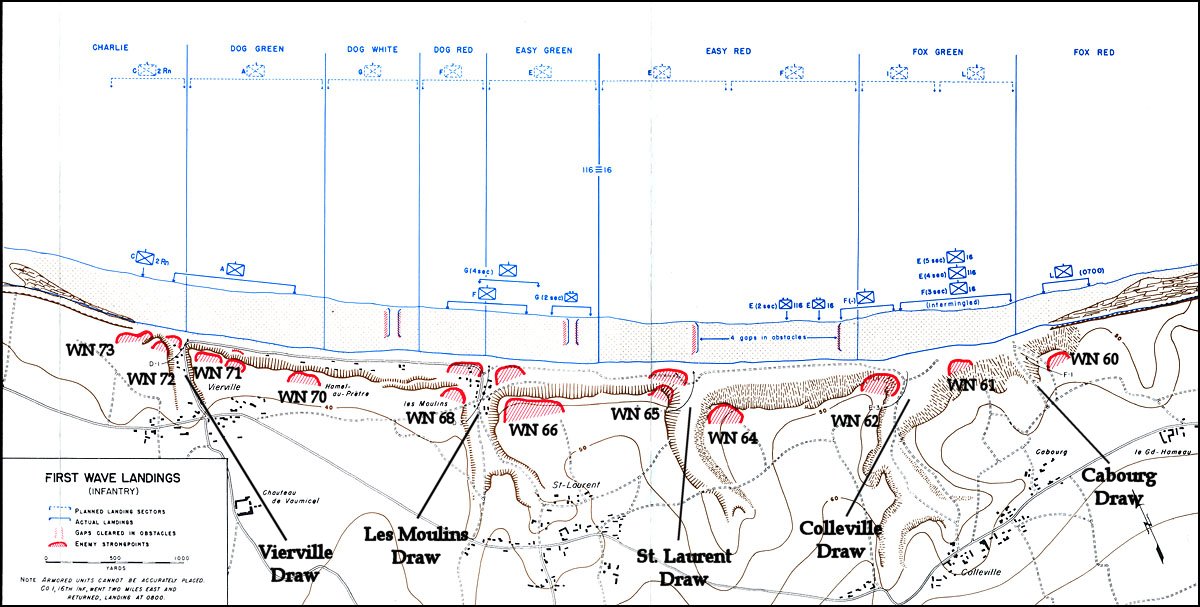Omaha Beach
Of the invasion beaches, Utah,Omaha, Gold, Juno, and Sword, the issue
was in doubt only on Omaha Beach. Bad Allied decisions could only
do so much harm on other beaches, but they nearly resulted in a
disastrous defeat
on Omaha Beach. Many lives were needlessly lost, and the whole
invasion was threatened with failure by the difficulties there.
In "Omaha Beach - A Flawed Victory", Adrian Lewis
convincingly
shows this. A synposis
follows.
British amphibious doctrine
was to use surprise and infiltration, preferably at night. This
was appropriate for the more scarce resources available and reflected
the possibility that a portion of an attack could fail. US
Pacific doctrine was to
use massive firepower followed by direct assault. This was
appropriate considering the massive resources available and the
tradition of victory. In the interests of iter-Allied unity, in
December 1943 a compromise, hybrid doctrine was forged from the British
and American doctrines by Montgomery and Bradley in which a landing
would be made in the early daylight hours. It was hoped that this
would allow for time for an aerial and naval bombardment - and to
make sure that the landing craft went ashore in the proper places.
This decision was made from the top, not from the advice and
input from the commanders who would lead the assault. It
was based on faulty assumptions about what air power could do -
that it could accurately hit strongpoints and clear enemy barbed wire.
The Army Air Corps leadership was perpetually optimistic about
their abilities and too focused on the strategic bombardment of Germany
to give much attention to the support of ground troops. It was a
mission that had never been done before, and it relied on a new radar
system. Nevertheless, there was no training.
Because it was an early morning landing, the naval bombardment
was shorter than it could be. Much of the naval bombardment
focused on counter-battery fire by battleships. Bombardment of
the beach defenses would be conducted by cruisers and destroyers
begining only 20 minutes before landing, with battleships lending
help only after counter-battery fire was done. Immediately
upon landing, the bombardment would shift inland. The
planners did not want the naval or air bombardment to create so
much destruction as to hamper buildup of the beach-head or to create
water filled craters which might drown the assault force. At any
rate, only two battleships, four cruisers, and 12 destroyers would
conduct the bombardment, completely inadequate as doctrine stated.
Landing craft equiped with rockets would also be used in the
final seconds before landing; Their firepower was enormous, but it was
not matched by their accuracy, which was sadly lacking. The early
morning landing also meant that the landing craft were loaded and
approached the shore during darkness. Many of them would land far
off course. In essence, the Allied plan featured all the problems
of a night attack, without the benefits of one, and without the
benifits of a daytime attack either.
The plan for clearance of beach obstacles was also flawed.
Bradley rejected advice from his corps commander, Gerow, and the
navy, to give more time, pre-invasion, to clear beach obstacles.
As a result, the engineers landed with the assault infantry and
had enormous difficulty due to enemy fire combined with a rising tide.
Tank support, which might have helped alleviate all the other
issues that the assault faced, was lacking because many of the
amphibious duplex drive tanks were launched too far from shore and
quickly swamped. Of the tanks available, none were the British
'funnies' specially designed for beach assault tasks like mine clearing
or flame throwing into pillboxes. The British offer of these
vehicles had been declined.
The composition of the assault was also an issue. Instead of
having men from a single division land on Omaha beach, two regiments
from two different divisions were landed. The purpose of this was
to make the move inland and laterally from the beach-head easier, but
it complicated the command of the assault itself. When the beach
was initially selected, it had few defenders. Over time, though,
more Germans arrived, but changing the assault to another beach was
never seriously considered. In addition, the Germans had placed a
new unit on the beach defenses, the 352nd Division, but Allied
intelligence, despite having broken the German codes, and despite help
from the French Resistance, failed to detect the new position of the
352nd.
Landing Craft and Beach Defenses
Normandy American Cemetery
Vierville Draw
Les Moulins and St. Laurent Draws
Colleville Draw
Cabourg Draw
These maps from the US Army are a handy reference for this confusing battle.


From left (west) to right (east), the draws are Vierville or D-1,
Les Moulins or D-3, St. Laurent or E-1, Colleville or E-3, and Cauburg
or F-1.
Copyright 2010 by John Hamill

